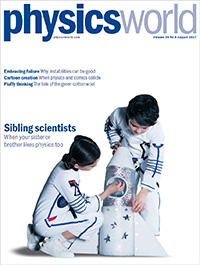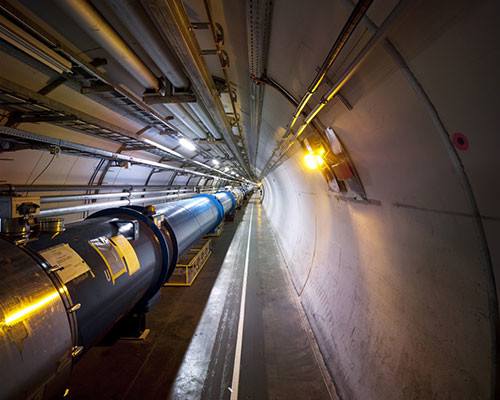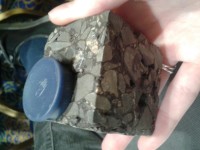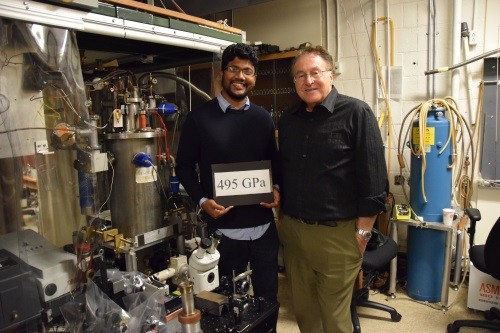Tag archives: materials science
The August 2017 issue of Physics World is now out
 By Matin Durrani
By Matin Durrani
Who inspired you to study physics? Perhaps you had a great teacher or a supportive parent. But how might it feel if you’ve got a sibling who’s also into the subject? Would they be your rival or would the two of you support and nurture each other?
These issues facing “sibling scientists” are the cover feature of the August issue of Physics World magazine, which is now out. Turns out that sibling scientists are generally a force for good, especially with the elder child acting as a mentor and guide – often providing information, support and advice to the younger sister or brother.
I wonder in fact if we should do more to encourage boys and girls who are already in thrall with physics to persuade their siblings into the subject too. Of course, our feature isn’t an exhaustive scientific study, so do tell us if you know of other examples of sibling science.
Remember that if you’re a member of the Institute of Physics, you can read Physics World magazine every month via our digital apps for iOS, Android and Web browsers.
View all posts by this author | View this author's profile
Probing the quantum nature of water
By James Dacey in Beijing on Friday 4 November
After enjoying clear blue skies for the first couple of days of my visit to Beijing, the breeze has disappeared and the smog has taken its hold. One local scientist told me this latest wave is due to pollution from factories south-west of the city, but others have told me it is difficult to pinpoint a particular source. Facemasks are being worn by every other person in the streets, but fortunately I’ve been sheltered by the walls and ceilings of Peking University (PKU).
View all posts by this author | View this author's profile
Physics saves humanity, the large rainfall collider and other environmental highlights on Earth Day

Gravity’s pull: could the LHC be used as a giant rain gauge? (Courtesy: CERN)
By James Dacey and Hamish Johnston
Today is Earth Day, so let’s temporarily rename this regular Red Folder column as the Green Folder. Either way, today we’re going to focus on the Earth and environmental issues. The official website of Earth Day – an initiative now in its 46th year – has details about the various initiatives and events taking place around the world today.
First, let’s pay tribute to a physicist whose work had a profound influence on the climate and energy debate in the UK and beyond. Sir David Mackay died on 14 April aged 48 following a battle with cancer. Mackay is remembered among other things for his pragmatic approach to energy and his 2008 book Sustainable Energy: Without the Hot Air (free access) was hailed for its rigour and refreshing absence of rhetoric. Mackay’s writings attracted the interest of the British government who appointed him as chief scientific adviser to the Department of Energy and Climate Change in 2009, a post he held for five years. Ever prolific, Mackay was blogging about his experiences right up until two days before his death.
Something more concrete

A sample of asphalt to which steel-wool fibres have been added, making the material magnetic.
By Margaret Harris at the AAAS Meeting in Washington, DC
Although Thursday’s LIGO result was extremely exciting, I’m afraid I can only spend so much time pondering ripples in the fabric of space–time before I start yearning for something a little more…concrete. Like, well, concrete. And asphalt. And cement. These decidedly ordinary materials were the stars of two of the most fascinating talks I’ve seen at the AAAS meeting here in Washington DC over the past two days.
First up was Erik Schlangen, a civil engineer at the Delft University of Technology in the Netherlands who develops “self-healing” materials. One of his projects (which you can watch him demonstrate in a TED talk) involves mixing porous asphalt with fibres of steel wool. The resulting conglomerate is magnetic (that’s a magnet sticking to it in the photo), which means that microscopic cracks in it can be repaired using induction heating. The heat melts the bitumen in the asphalt, allowing it to re-fuse, but the surrounding aggregate remains relatively cool – meaning that cars can be driven over asphalt road surfaces almost as soon as the repair is complete.
View all posts by this author | View this author's profile
Scientists officially ground Spider-Man

Stick together: both ants and geckos have adhesive pads that let them scale vertical surfaces. (Courtesy: A Hackmann/D Labonte)
By Tushna Commissariat
Don’t tell the kids just yet, but becoming Spider-Man, even after being bitten by a radioactive spider, is looking less and less likely for us humans – we are just too big. The latest work, done by researchers at the University of Cambridge in the UK, has shown that gecko-sized is pretty much the largest you can be if you realistically want to scale up walls with adhesive pads. Any bigger, and most of your surface area would need to be covered in large sticky pads to pull off the gravity-defying walk. Indeed, the team estimates that roughly 40% of an average human being’s total body surface would need to be sticky – this means a whopping 80% of your front would be covered in adhesive pads.
Soft hair on black holes, making concrete on Mars and exploring the cosmos in 2016
By Hamish Johnston
This week’s Red Folder looks to the cosmos, starting with a spiffy new video from the European Space Agency. The slick presentation is a preview of some of the extra-terrestrial exploits that the agency has planned for 2016. This includes the landing of the Schiaparelli probe on the surface of Mars. This stationery lander will survey its Martian environs to find a suitable location to drop the ExoMars rover in 2018. The mission’s namesake is the Italian astronomer Giovanni Schiaparelli, who mapped the surface of Mars and was the first to use the term canali to describe the straight lines that were thought to exist on the surface of the planet.
It’s possible that someday humans will colonize Mars and this will involve building dwellings and other structures on the Red Planet. In preparation, Lin Wan, Roman Wendner and Gianluca Cusatis at Northwestern University in the US have come up with a recipe for making concrete on Mars. The trio reckon that any successful colonization of the Red Planet will have to rely on local building materials because shipping stuff from Earth would be horrendously expensive.
Marking time on precision engineering

Adventures in science: the Magna centre in Rotherham, UK.
By Susan Curtis
At a time when the UK steel industry is close to meltdown, it felt quite humbling to be standing inside a disused steelworks on the outskirts of Rotherham. In its heyday in the 1970s the colossal plant employed 3000 people and housed six electric arc furnaces that set new records for steel production. Since closing in 1993, the facility has forged a new identity as the Magna Science Adventure Centre, which offers visitors an insight into the steel-making process and its heritage in the area around Sheffield.
Recently, I was at Magna for the annual TRAM conference, which showcases the latest technology advances in the aerospace industry. Organized by the Advanced Manufacturing Research Centre (AMRC), one of the UK’s Catapult centres based at the University of Sheffield and supported by Boeing, TRAM highlights how aircraft makers and their suppliers are improving materials and manufacturing processes to reduce cost and enhance performance. But among the talk of powder metallurgy, high-performance machining and the factories of the future, a presentation by Nick English from the UK-based watchmaker Bremont highlighted manufacturing innovation at a much smaller scale.
View all posts by this author | View this author's profile
The November 2015 issue of Physics World is out now
By Matin Durrani
Whether it’s the shortest wavelength, the lightest particle, the highest pressure or the brightest beam, there’s something intrinsically appealing about pushing boundaries to break records and establish new limits of what’s physically possible. Reaching new extremes is healthy for science too, spurring researchers to outperform rivals in the quest for grants, kudos or new jobs.
The November 2015 issue of Physics World, which is now out, covers three frontier-busting research endeavours. We kick off by looking at a human-made extreme: the search for the blackest materials ever produced – a tale that’s had a dark side of its very own. Next, we examine how physics techniques are unravelling the secrets of tough lifeforms that exist in some of the most extreme environments on Earth. Finally, we go beyond Earth to a cosmic extreme: magnetars – a special kind of rotating neutron star that are the strongest magnets in the universe.
Examining precious artefacts without breaking them
By James Dacey in Mexico
From pre-Hispanic archaeological treasures to the Modernist paintings of Frida Kahlo and Diego Rivera, Mexico is brimming with cultural artefacts. Yesterday I visited a centre at the National Autonomous University of Mexico (UNAM) that has developed techniques for investigating precious objects without damaging them.
View all posts by this author | View this author's profile
